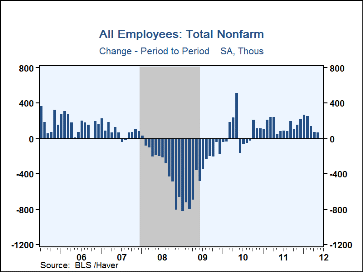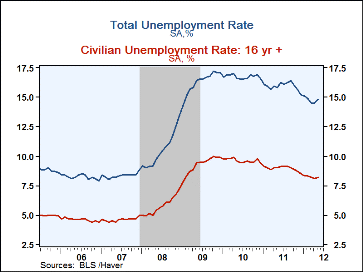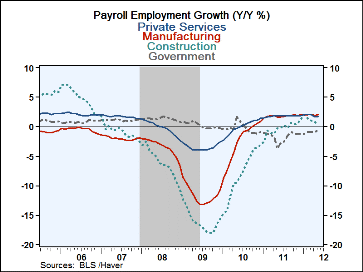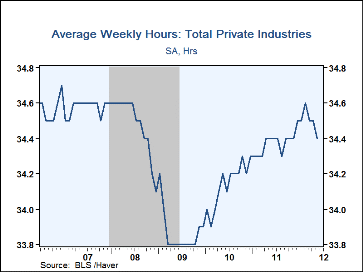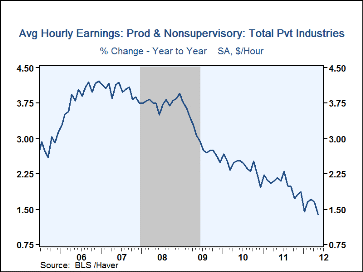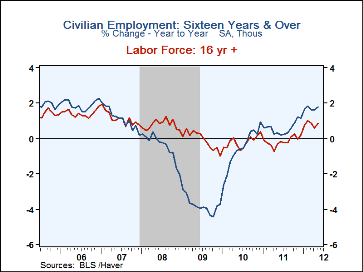 Global| Jun 01 2012
Global| Jun 01 2012U.S. Employment Report Disappoints By All Measures
by:Tom Moeller
|in:Economy in Brief
Summary
Difficulty in seasonally adjusting for the near-record winter temperatures may have been at work. Nevertheless, nonfarm payrolls grew just 69,000 last month following a downwardly revised 77,000 April increase, originally reported as [...]
Difficulty in seasonally adjusting for the near-record winter temperatures may have been at work. Nevertheless, nonfarm payrolls grew just 69,000 last month following a downwardly revised 77,000 April increase, originally reported as 115,000. A 158,000 rise had bee expected. The length of the average workweek, 34.4 hours, fell to its lowest in six months. Adding to the disappointment was a 0.1% decline in average hourly earnings and an uptick in the unemployment rate to 8.2%; 8.1% had been expected.
From the establishment employment survey, nonfarm payrolls in May rose just 69,000 after gains of 77,000 and 143,000 during the prior two month, revised from 115,000 and 154,000, respectively. Weakened job figures spread throughout industries. To the down side, construction employment fell 28,000 (+0.3% y/y) and was down for the fourth straight month. Government payrolls also fell 13,000 (-0.7% y/y) led by 5,000 worker declines in both federal (-1.7% y/y) and state government (-0.3% y/y) payrolls. Local government payrolls also were off 3,000 (-0.7% y/y).
To the upside, a 12,000 increase (1.9% y/y) in factory payrolls was improved from April but it remained well below the 28,000 to 52,000 gains during the prior four months. Amongst private service industries, payrolls grew just 97,000 (1.8% y/y) after an 83,000 April increase. During the prior six months monthly gains averaged 169,000. Firm job increases were registered in education, up 11,900 (3.5% y/y) and health care & social assistance, up 34,000 (2.2% y/y). Temporary service jobs increased a modest 9,000 (8.5% y/y). Weaker figures were logged elsewhere. In retail trade payrolls rose just 2,300 (0.9% y/y) following a 27,000 April gain. Information jobs fell 2,000 (-1.6% y/y) and financial industry employment rose just 3,000 (0.4% y/y). Jobs in real estate & rental rose 6,600 (1.4% y/y) but professional & business service employment fell 1,000 (+3.0% y/y). Leisure & hospitality jobs fell 9,000 (+2.2% y/y).
The length of the average private-sector workweek slipped to 34.4 hours, the lowest in nine months. Private services hours plunged to 33.2 after having risen to 33.4 in March. The factory sector workweek fell to 40.5 hours after 40.9 three months ago. The index of aggregate hours worked (employment time hours) fell for the second month in the last three and the Q2 average so far is equal to Q1.
Average hourly earnings slipped 0.1% (+1.4% y/y), the first decline in nine months. It reflected a 0.1% decline (+1.4% y/y) in goods producing industries and a 0.1% slip (+1.4% y/y) in private services.
From the household employment survey, the unemployment rate ticked up to 8.2% reflecting a 422,000 (1.8% y/y) rise in employment and a 642,000 (0.9% y/y) increase in the labor force. The overall unemployment rate including marginally attached workers and those involuntarily working part time was 14.8%. As workers sensed an improved job market, the labor force participation rate rose to a still-low 63.8%. The unemployment rate for adult men of 7.8% compared to 7.4% for women. The teenage unemployment rate averaged 24.6%.
By education level, the jobless rate averaged 13.0% for those with less-than a high school diploma, 8.1% for high school no college, 7.9% for some college and 3.9% for college graduates. The average duration of unemployment rose to 39.7 weeks but that still was down from the peak six months ago of 40.9 hours. For those unemployed, 31.1% were out of work 52 weeks or longer.
The figures referenced above are available in Haver's USECON database. Additional detail can be found in the LABOR and in the EMPL databases. The expectation figures are from Action Economics and are in the AS1REPNA database.
Measuring Small Business Employment over the Business Cycle from the Federal Reserve Bank of Cleveland is available here.
| Employment: (M/M Chg., 000s) | May | Apr | Mar | Y/Y | 2011 | 2010 | 2009 |
|---|---|---|---|---|---|---|---|
| Payroll Employment | 69 | 77 | 143 | 1.4% | 1.2% | -0.7% | -4.4% |
| Previous | -- | 115 | 154 | -- | -- | -- | -- |
| Manufacturing | 12 | 9 | 42 | 1.9 | 1.8 | -2.7 | -11.6 |
| Construction | -28 | -5 | -14 | 0.3 | -0.3 | -8.2 | -16.0 |
| Private Service Producing | 97 | 83 | 119 | 1.8 | 1.8 | -0.1 | -3.5 |
| Government | -13 | -10 | -4 | -0.7 | -1.7 | -0.3 | 0.2 |
| Average Weekly Hours - Private Sector | 34.4 | 34.5 | 34.5 | 34.4 (May'11) |
34.4 | 34.1 | 33.9 |
| Average Hourly Earnings (%) | -0.1 | 0.2 | 0.1 | 1.4 | 2.0 | 2.4 | 3.0 |
| Unemployment Rate (%) | 8.2 | 8.1 | 8.2 | 9.0 (May'11) |
9.0 | 9.6 | 9.3 |
Tom Moeller
AuthorMore in Author Profile »Prior to joining Haver Analytics in 2000, Mr. Moeller worked as the Economist at Chancellor Capital Management from 1985 to 1999. There, he developed comprehensive economic forecasts and interpreted economic data for equity and fixed income portfolio managers. Also at Chancellor, Mr. Moeller worked as an equity analyst and was responsible for researching and rating companies in the economically sensitive automobile and housing industries for investment in Chancellor’s equity portfolio. Prior to joining Chancellor, Mr. Moeller was an Economist at Citibank from 1979 to 1984. He also analyzed pricing behavior in the metals industry for the Council on Wage and Price Stability in Washington, D.C. In 1999, Mr. Moeller received the award for most accurate forecast from the Forecasters' Club of New York. From 1990 to 1992 he was President of the New York Association for Business Economists. Mr. Moeller earned an M.B.A. in Finance from Fordham University, where he graduated in 1987. He holds a Bachelor of Arts in Economics from George Washington University.


